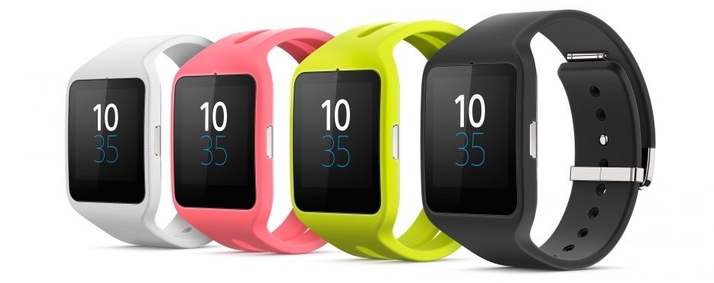See our chart of the best smartwatches and What is Google Android Wear? Update February 2017: Sony has confirmed that Android Wear 2.0 will not roll out to the Sony Smartwatch 3, given that it supports updates for 18 months after a product has launched. It says this is because it thinks the current operating system is better suited to the device, though we can’t help wondering whether this means a Smartwatch 4 is on the way.
Sony SmartWatch 3 review: design and build
It may not be quite as stylish as some circular smartwatches, but the SmartWatch 3 has a certain charm about it. There’s no big SONY logo or anything to draw your eye away from the 1.6in square colour screen. The only button is to the right, but you’ll rarely need it as the display lights up when you raise your arm or tap on the screen. There’s a choice of black or yellow straps (more will be available soon), and it’s simple to pop out the display unit and swap straps. It’s possible there will be third-party straps in future, but currently you’re limited to the official pair which cost £20 each. Obviously, you get one in the box. They’re made from sturdy rubber and have an equally sturdy buckle mechanism like you’d find on a metal-strapped gents watch. It’s easy to adjust the strap for size without cutting. We found the rubber uncomfortable to wear when hot – sweat is trapped under it, so it’s best to take it off regularly, and certainly at night. Instead of wireless charging, Sony has opted for a standard microUSB port. That’s great news in some ways as you can charge it practically anywhere; there’s a good chance that any given office or home will have a microUSB cable and charger. The USB port is covered by a captive rubber bung – the watch has an IP68 rating, so it’s dust and water resistant. We wouldn’t advise swimming with it, but you’ll be ok in the shower or going for a run in the rain.
Sony SmartWatch 3 review: Screen and battery life
We found the 420mAh battery lasted exactly two days, which is slightly disappointing given then unusual screen technology. Instead of AMOLED or IPS, Sony has gone for transflective which means the display is still readable – given sufficient ambient light – without the backlight. It’s the same technology used in many outdoor GPS devices. You can choose whether or not to keep the screen on all the time. If you turn it off, you’ll have to wake it up just to check the time, but if you leave it on permanently, you can merely glance at your wrist without having to tap or lift your arm. Sony has also included an ambient light sensor so brightness can be adjusted automatically, but it doesn’t appear to yield any extra battery life. The 320×320 display has a few more pixels than the circular watches we’ve seen but there’s no real difference in the amount of information shown. The disadvantage of using a transflective display is that while colours look ok square-on, viewing angles are terrible by today’s standards. If battery life were more like 4-5 days we’d forgive this, but LG’s G Watch R also lasts two days between charges. Recharge time is roughly an hour.
Sony SmartWatch 3 review: Features
Storage remains the same as the Sony SmartWatch 2 and rival Android Wear devices at 4GB eMMC flash memory. This can be used to store music which can be played without a companion smartphone or tablet via Bluetooth. The SmartWatch 3 does have one ace, though: built-in GPS. With an on-board receiver, there’s no need to take your smartphone with you on a run, hike or bike ride. The GPS can record your route and feed the data back to the Sony Lifelog app. There’s also NFC, a gyro, compass, accelerometer and Bluetooth. The latter isn’t merely useful for connection to a smartphone for Android notifications: you can pair the SmartWatch 3 with some headphones and listen to music stored on the watch (there’s 2.6GB of usable storage) when you’re exercising. What it doesn’t have is a heart-rate monitor, although that doesn’t mean the G Watch R is the best choice for fitness enthusiasts. The LG has a heart-rate sensor, which takes on-demand readings rather than monitoring heart rate over time. If you need that, consider one of the new Fitbit trackers: the Charge HR or Surge. Also, unlike those activity trackers and Sony’s own SmartBand Talk, the SmartWatch 3 has no barometer to detect floors climbed and neither does it track your sleep. You can install apps on Android Wear, though, which add functions and features which could be even more useful. Right now the selection is rather thin on the ground, but it’s sure to improve over time. A recent update to Android Wear 5.0 has fixed some of the issues with this fledgling operating system, but it’s still a work in progress. First-time users are likely to be surprised and frustrated by how much still needs to be done on the paired smartphone: you can preview messages but not reply, and ask for directions but be forced to use the phone to see a map, for example. You can use Ok Google for many things, such as web searches, sending texts and emails, setting timers and alarms and more. It’s all a bit fiddly to set up and learn the specific commands, but once done it does work quite well. Jim has been testing and reviewing products for over 20 years. His main beats include VPN services and antivirus. He also covers smart home tech, mesh Wi-Fi and electric bikes.




